In this tutorial, we will show you how to install and run WhatsApp on the Ubuntu operating system.
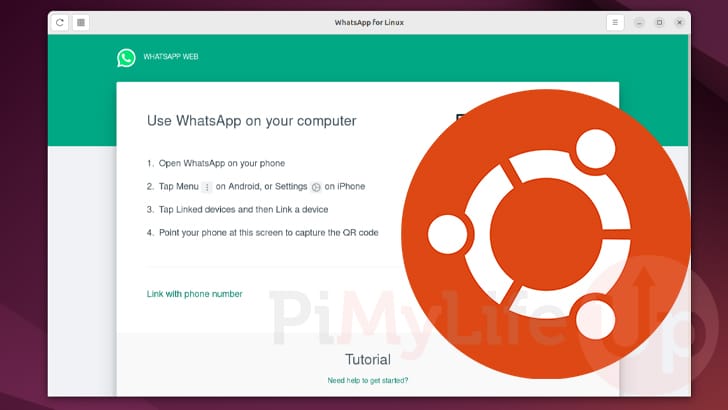
WhatsApp is a popular messaging and VOIP platform developed and run by Meta. It is considered a more cost-effective alternative to traditional SMS messaging in many countries.
While WhatsApp does not officially support Linux-based operating systems, its web-based client allows us to use a variety of easy-to-use workarounds.
In this guide, we will cover two different methods for running WhatsApp on Linux. The first is to create a shortcut to Chrome that will act as an independent WhatsApp app. The biggest advantage of this method is that it does not rely on a third party; you are essentially just loading the WhatsApp web client in a web browser.
The other method we will cover is using the WhatsApp for Linux client by Enes Hecan. This client offers a more native implementation of WhatsApp on Ubuntu. The downside of this solution is that you are relying on a third party and have to put some trust in their code. The WhatsApp for Linux project is at least open source.
No matter how you install this chat client, you will need to run a desktop variant of Ubuntu.
Please note that while you can access WhatsApp, you won’t be able to create an account. At the time of publishing, you can only create an account through the official Google Play or Apple Store apps.
Creating your Own WhatsApp Web App on Ubuntu
In this section, we will show you how to easily set up your own WhatsApp Web App on Ubuntu. This web app is essentially just a desktop icon that launches Chrome in its inbuilt “app” mode.
This app loads straight into the “web.whatsapp.com” website and gives you a relatively good experience. Best of all, you aren’t reliant on any third-party apps to access your WhatsApp account.
Preparing Ubuntu to run WhatsApp
1. The following steps assume you are within the terminal. If you don’t know how to open the terminal on Ubuntu, you can use the CTRL + ALT + T shortcut.
2. With the terminal open, your first step will be to ensure the packages on your Ubuntu system are up-to-date.
You will update the package list cache using the following two commands and then upgrade any out-of-date packages.
sudo apt update
sudo apt upgradeCopy3. After updating your system, you must install the Google Chrome web browser. While you could also use Chromium, our guide is written with the expectation that you are using Google Chrome.
Unfortunately, Firefox won’t work at all as it lacks the functionality to be launched purely in an “app” mode.
If you don’t have Chrome installed on Ubuntu already, we recommend following our guide before proceeding.
https://pimylifeup.com/ubuntu-google-chrome/Writing a Shortcut to Launch WhatsApp
4. With everything now in place, we can move on to creating a shortcut that launches WhatsApp as a web app on our Ubuntu system.
By running the command below, you can begin writing this file using the nano text editor.
sudo nano /usr/share/applications/whatsapp-webapp.desktopCopy5. Within this file, you will want to type out the following lines. The main line that makes all this work is the “Exec” line.
Here you can see we launch the Google Chrome web browser and pass in “https://web.whatsapp.com” as the URL to load using the “--app” option. This option essentially locks this browser to that particular website.
[Desktop Entry]
Name=WhatsApp
GenericName=WhatsApp
Comment=WhatsApp Webapp
Exec=/opt/google/chrome/google-chrome --app=https://web.whatsapp.com/
Terminal=false
Type=Application
StartupNotify=true
MimeType=text/plain;
Categories=Network;Application;
Keywords=WhatsApp;webapp;
X-Ubuntu-Gettext-Domain=WhatsApp
StartupWMClass=web.whatsapp.comCopy6. After you have finished writing out the desktop file, save and quit by pressing CTRL + X, Y, and then ENTER.
Opening your new WhatsApp Web App on Ubuntu
7. Now that the WhatsApp web app has been created on your Ubuntu system, you will obviously want to know how to launch it.
Start by bringing up the applications menu by clicking the top or bottom left side of the screen.
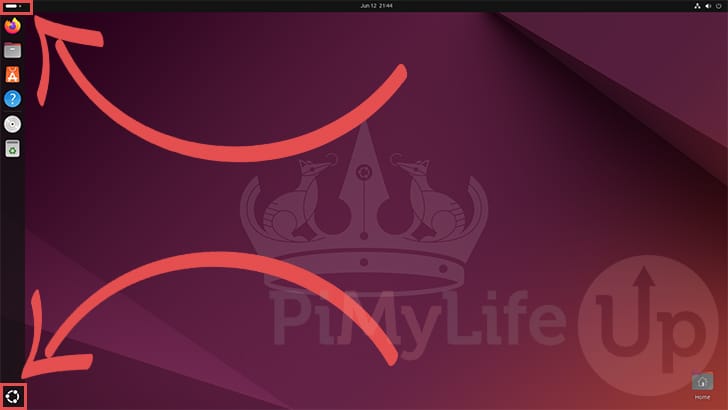
8. With this menu open, you should use the search box in the middle of the screen to search for “Whatsapp” (1.).
You should see a single app appear without an icon. This is your new WhatsApp web app. Click this icon to launch the chat client (2.).
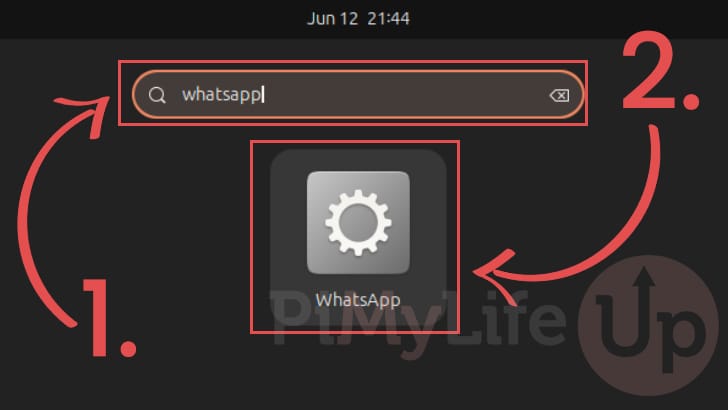
9. Below, you can see that WhatsApp is now running on Ubuntu and waiting for us to connect our account using the provided QR code.
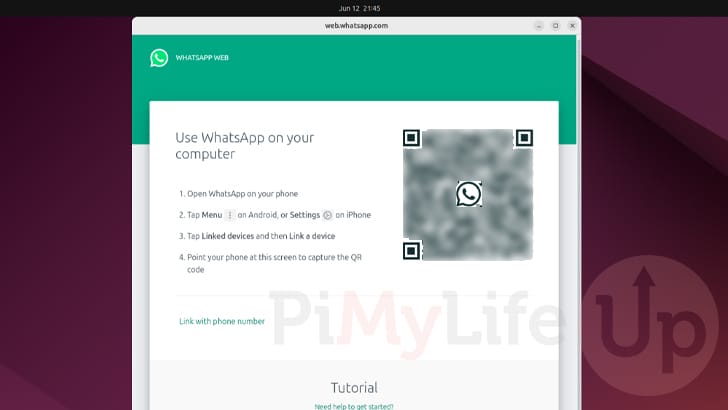
Installing the WhatsApp for Linux Client on Ubuntu
In this section, we will show you how to install the WhatsApp for Linux client on your Ubuntu machine.
As we mentioned at the start of this guide, this client is not an official one provided by WhatsApp. It was developed by a third party, so there is some risk in utilizing it. However, the code for this project is at least available on their GitHub.
The client we are showcasing in this section is installed using Ubuntu Snap. A Snap is like a special package of software that includes all the required dependencies.
Preparing your System
1. To install the WhatsApp for Linux client on your Ubuntu system, you will need to open up the terminal.
You can open the terminal quickly by pressing CTRL + ALT + T on your keyboard.
2. With the terminal open, your first step is to ensure all your packages are updated by using the following two commands.
We do this to ensure we have the latest version of the snap core. Snap is included by default on the Ubuntu operating system.
sudo apt update
sudo apt upgrade -yCopyUsing Snap to Install the WhatsApp for Linux Client on Ubuntu
3. Once your system has been updated, you can install the WhatsApp for Linux client by running the command below.
This will immediately begin installing the WhatsApp chat client. The process can take a couple of minutes to complete, as Snap is typically heavier than a typical package.
sudo snap install whatsapp-for-linuxCopyLaunching the WhatsApp for Linux Client
4. To open the WhatsApp for Linux client on Ubuntu, you must first open the applications menu.
You can open this menu by clicking the bottom or top left of the screen.

5. On this next screen, use the search box to look for “whatsapp” (1.).
You should eventually see an application called “WhatsApp for Linux” appear on the screen. Click this application to open it (2.).
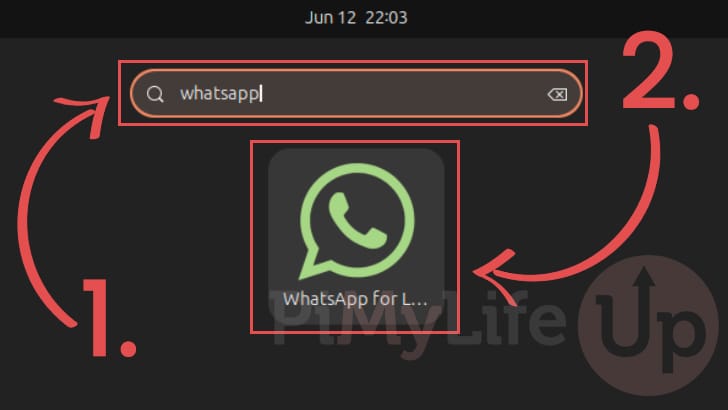
6. Below, you can see that we now have the WhatsApp for Linux client up and running on our Ubuntu device.
It works very similar to the custom web app we created in our other section but has a few additional bits of functionality baked in. It still relies on the WhatsApp web app.
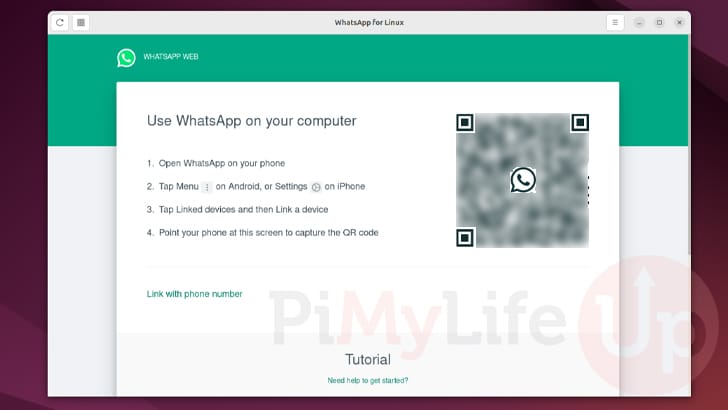
Conclusion
Hopefully, at this stage, you will have successfully installed WhatsApp and made it run on your Ubuntu machine.
This app is a super popular chat client and has become popular around the world as an excellent alternative to traditional SMS messaging.
Please feel free to comment below if you have issues getting this chat client to run on your Ubuntu machine.
If you liked this guide, we recommend that you check out our many other Ubuntu tutorials.









